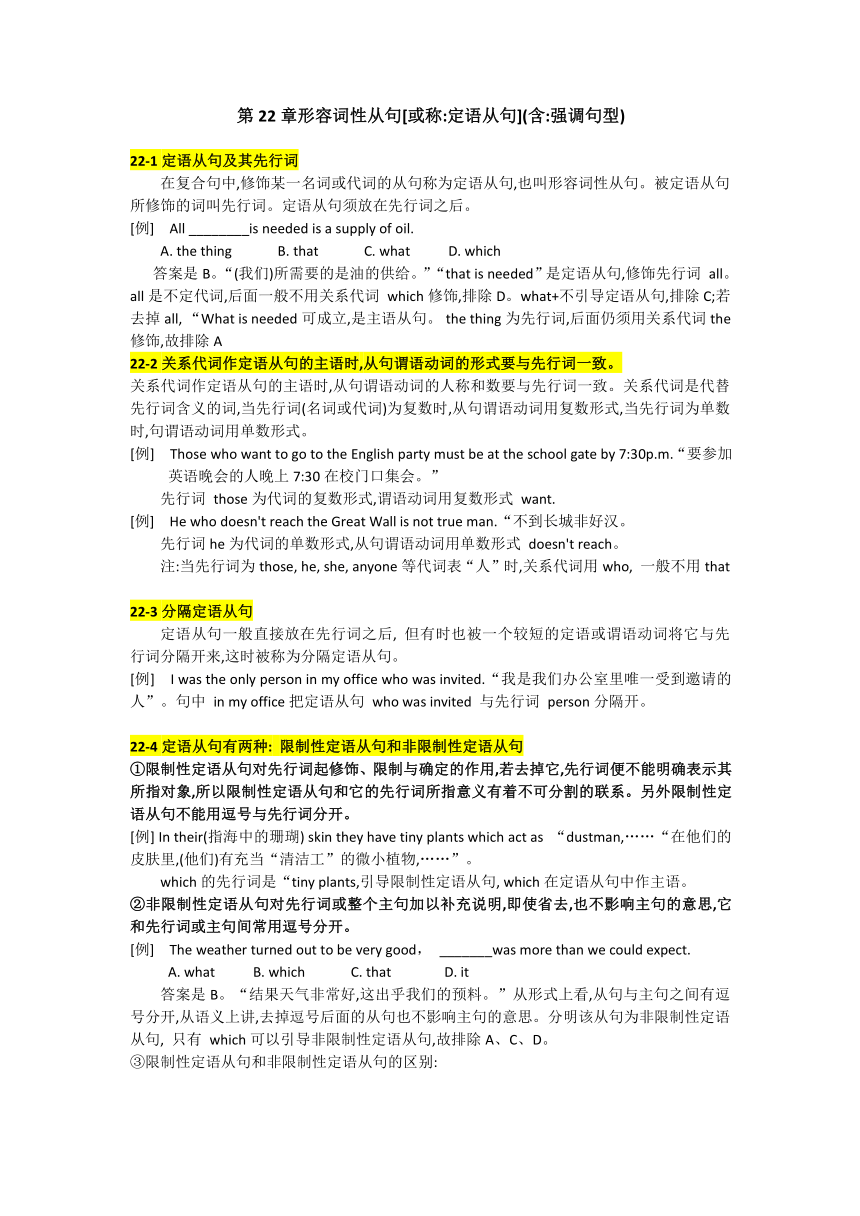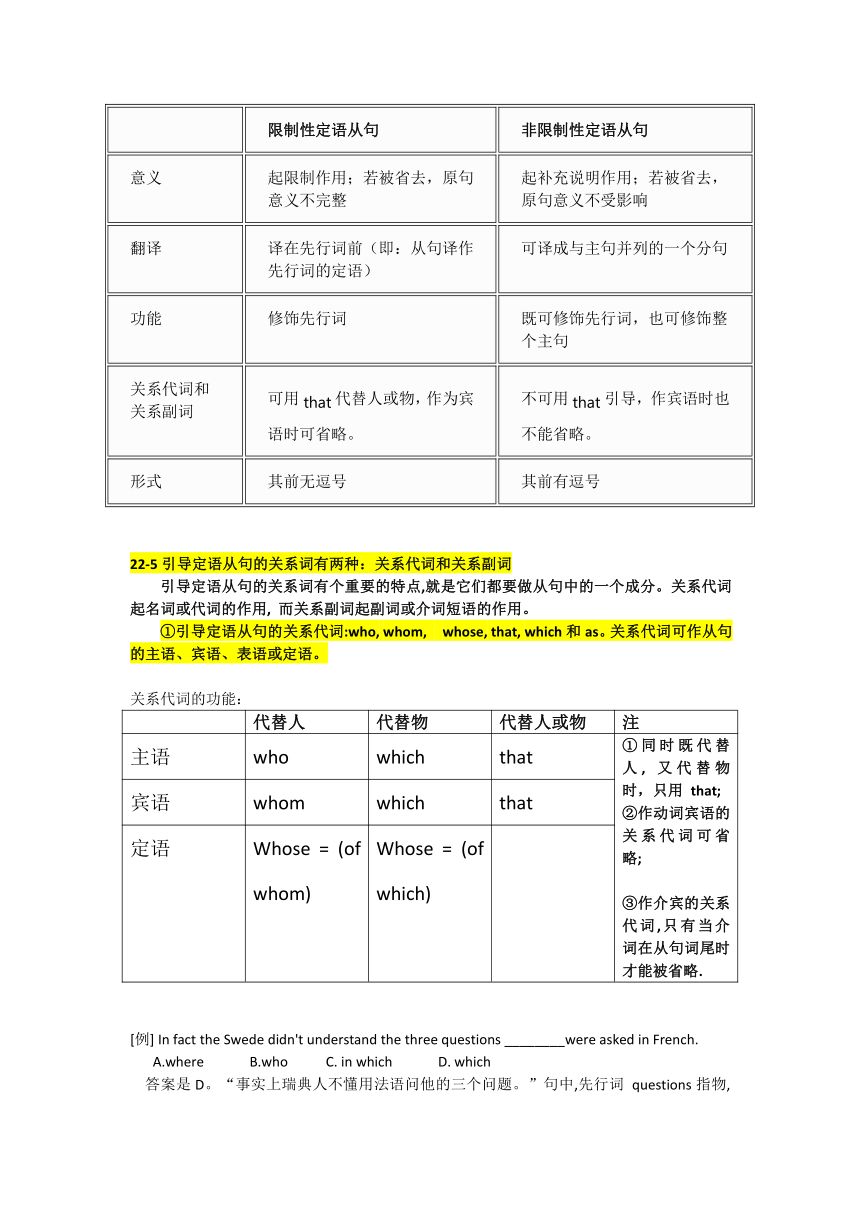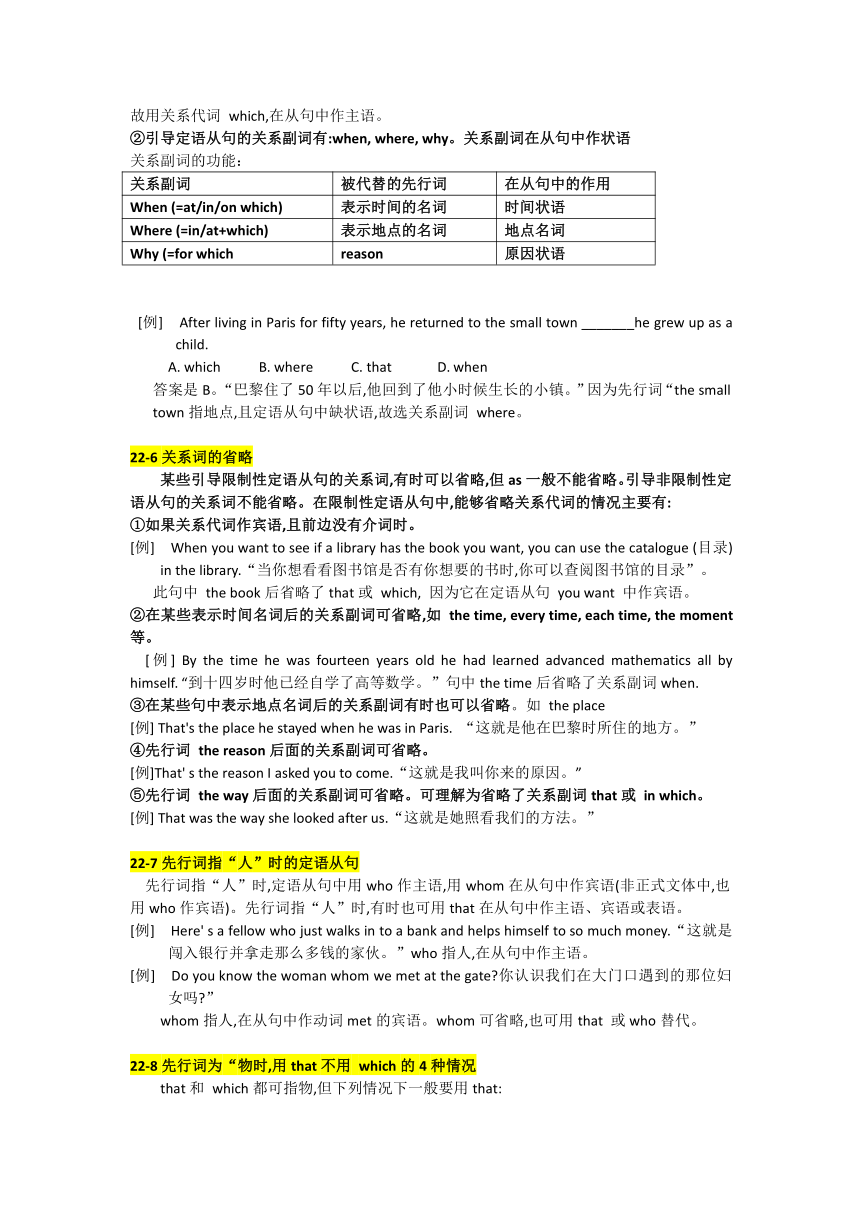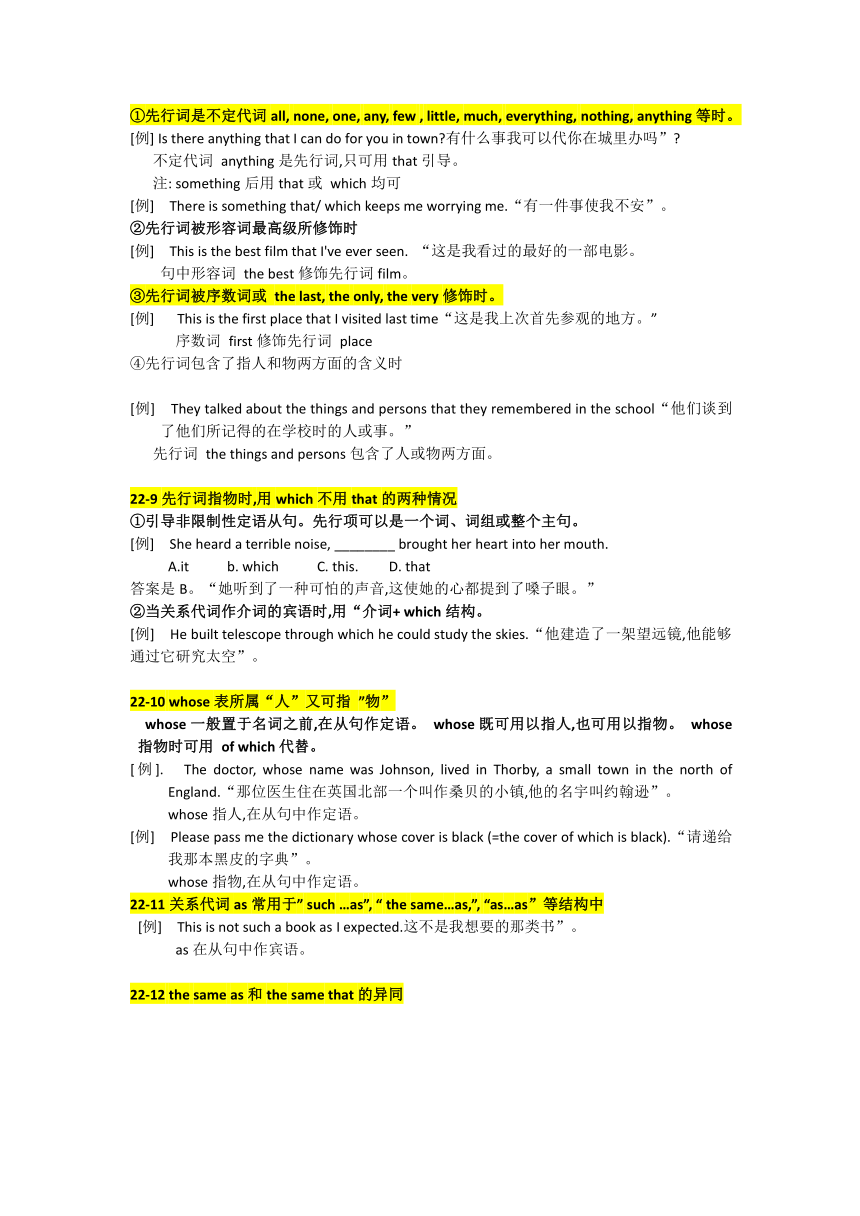定语从句 (和强调句型)(英语语法第22章)讲义-2025届高三上学期英语二轮复习专项
文档属性
| 名称 | 定语从句 (和强调句型)(英语语法第22章)讲义-2025届高三上学期英语二轮复习专项 |  | |
| 格式 | docx | ||
| 文件大小 | 324.5KB | ||
| 资源类型 | 教案 | ||
| 版本资源 | 人教版(2019) | ||
| 科目 | 英语 | ||
| 更新时间 | 2025-01-06 10:41:48 | ||
图片预览




文档简介
第22章形容词性从句[或称:定语从句](含:强调句型)
22-1定语从句及其先行词
在复合句中,修饰某一名词或代词的从句称为定语从句,也叫形容词性从句。被定语从句所修饰的词叫先行词。定语从句须放在先行词之后。
[例] All ________is needed is a supply of oil.
A. the thing B. that C. what D. which
答案是B。“(我们)所需要的是油的供给。”“that is needed”是定语从句,修饰先行词 all。 all是不定代词,后面一般不用关系代词 which修饰,排除D。what+不引导定语从句,排除C;若去掉all, “What is needed可成立,是主语从句。 the thing为先行词,后面仍须用关系代词the修饰,故排除A
22-2关系代词作定语从句的主语时,从句谓语动词的形式要与先行词一致。
关系代词作定语从句的主语时,从句谓语动词的人称和数要与先行词一致。关系代词是代替先行词含义的词,当先行词(名词或代词)为复数时,从句谓语动词用复数形式,当先行词为单数时,句谓语动词用单数形式。
[例] Those who want to go to the English party must be at the school gate by 7:30p.m.“要参加英语晚会的人晚上7:30在校门口集会。”
先行词 those为代词的复数形式,谓语动词用复数形式 want.
[例] He who doesn't reach the Great Wall is not true man.“不到长城非好汉。
先行词he为代词的单数形式,从句谓语动词用单数形式 doesn't reach。
注:当先行词为those, he, she, anyone等代词表“人”时,关系代词用who, 一般不用that
22-3分隔定语从句
定语从句一般直接放在先行词之后, 但有时也被一个较短的定语或谓语动词将它与先行词分隔开来,这时被称为分隔定语从句。
[例] I was the only person in my office who was invited.“我是我们办公室里唯一受到邀请的人”。句中 in my office把定语从句 who was invited 与先行词 person分隔开。
22-4定语从句有两种: 限制性定语从句和非限制性定语从句
①限制性定语从句对先行词起修饰、限制与确定的作用,若去掉它,先行词便不能明确表示其所指对象,所以限制性定语从句和它的先行词所指意义有着不可分割的联系。另外限制性定语从句不能用逗号与先行词分开。
[例] In their(指海中的珊瑚) skin they have tiny plants which act as “dustman,……“在他们的皮肤里,(他们)有充当“清洁工”的微小植物,……”。
which的先行词是“tiny plants,引导限制性定语从句, which在定语从句中作主语。
②非限制性定语从句对先行词或整个主句加以补充说明,即使省去,也不影响主句的意思,它和先行词或主句间常用逗号分开。
[例] The weather turned out to be very good, _______was more than we could expect.
A. what B. which C. that D. it
答案是B。“结果天气非常好,这出乎我们的预料。”从形式上看,从句与主句之间有逗号分开,从语义上讲,去掉逗号后面的从句也不影响主句的意思。分明该从句为非限制性定语从句, 只有 which可以引导非限制性定语从句,故排除A、C、D。
③限制性定语从句和非限制性定语从句的区别:
限制性定语从句 非限制性定语从句
意义 起限制作用;若被省去,原句意义不完整 起补充说明作用;若被省去,原句意义不受影响
翻译 译在先行词前(即:从句译作先行词的定语) 可译成与主句并列的一个分句
功能 修饰先行词 既可修饰先行词,也可修饰整个主句
关系代词和关系副词 可用that代替人或物,作为宾语时可省略。 不可用that引导,作宾语时也不能省略。
形式 其前无逗号 其前有逗号
22-5引导定语从句的关系词有两种:关系代词和关系副词
引导定语从句的关系词有个重要的特点,就是它们都要做从句中的一个成分。关系代词起名词或代词的作用, 而关系副词起副词或介词短语的作用。
①引导定语从句的关系代词:who, whom, whose, that, which和as。关系代词可作从句的主语、宾语、表语或定语。
关系代词的功能:
代替人 代替物 代替人或物 注
主语 who which that ①同时既代替人, 又代替物时,只用 that; ②作动词宾语的关系代词可省略; ③作介宾的关系代词,只有当介词在从句词尾时才能被省略.
宾语 whom which that
定语 Whose = (of whom) Whose = (of which)
[例] In fact the Swede didn't understand the three questions ________were asked in French.
A.where B.who C. in which D. which
答案是D。“事实上瑞典人不懂用法语问他的三个问题。”句中,先行词 questions指物,故用关系代词 which,在从句中作主语。
②引导定语从句的关系副词有:when, where, why。关系副词在从句中作状语
关系副词的功能:
关系副词 被代替的先行词 在从句中的作用
When (=at/in/on which) 表示时间的名词 时间状语
Where (=in/at+which) 表示地点的名词 地点名词
Why (=for which reason 原因状语
[例] After living in Paris for fifty years, he returned to the small town _______he grew up as a child.
A. which B. where C. that D. when
答案是B。“巴黎住了50年以后,他回到了他小时候生长的小镇。”因为先行词“the small town指地点,且定语从句中缺状语,故选关系副词 where。
22-6关系词的省略
某些引导限制性定语从句的关系词,有时可以省略,但as一般不能省略。引导非限制性定语从句的关系词不能省略。在限制性定语从句中,能够省略关系代词的情况主要有:
①如果关系代词作宾语,且前边没有介词时。
[例] When you want to see if a library has the book you want, you can use the catalogue (目录) in the library.“当你想看看图书馆是否有你想要的书时,你可以查阅图书馆的目录”。
此句中 the book后省略了that或 which, 因为它在定语从句 you want 中作宾语。
②在某些表示时间名词后的关系副词可省略,如 the time, every time, each time, the moment 等。
[例] By the time he was fourteen years old he had learned advanced mathematics all by himself. “到十四岁时他已经自学了高等数学。”句中the time后省略了关系副词when.
③在某些句中表示地点名词后的关系副词有时也可以省略。如 the place
[例] That's the place he stayed when he was in Paris. “这就是他在巴黎时所住的地方。”
④先行词 the reason后面的关系副词可省略。
[例]That' s the reason I asked you to come.“这就是我叫你来的原因。”
⑤先行词 the way后面的关系副词可省略。可理解为省略了关系副词that或 in which。
[例] That was the way she looked after us.“这就是她照看我们的方法。”
22-7先行词指“人”时的定语从句
先行词指“人”时,定语从句中用who作主语,用whom在从句中作宾语(非正式文体中,也用who作宾语)。先行词指“人”时,有时也可用that在从句中作主语、宾语或表语。
[例] Here' s a fellow who just walks in to a bank and helps himself to so much money.“这就是闯入银行并拿走那么多钱的家伙。”who指人,在从句中作主语。
[例] Do you know the woman whom we met at the gate 你认识我们在大门口遇到的那位妇女吗 ”
whom指人,在从句中作动词met的宾语。whom可省略,也可用that 或who替代。
22-8先行词为“物时,用that不用 which的4种情况
that和 which都可指物,但下列情况下一般要用that:
①先行词是不定代词all, none, one, any, few , little, much, everything, nothing, anything等时。
[例] Is there anything that I can do for you in town 有什么事我可以代你在城里办吗”
不定代词 anything是先行词,只可用that引导。
注: something后用that或 which均可
[例] There is something that/ which keeps me worrying me.“有一件事使我不安”。
②先行词被形容词最高级所修饰时
[例] This is the best film that I've ever seen. “这是我看过的最好的一部电影。
句中形容词 the best修饰先行词film。
③先行词被序数词或 the last, the only, the very修饰时。
[例] This is the first place that I visited last time“这是我上次首先参观的地方。”
序数词 first修饰先行词 place
④先行词包含了指人和物两方面的含义时
[例] They talked about the things and persons that they remembered in the school“他们谈到了他们所记得的在学校时的人或事。”
先行词 the things and persons包含了人或物两方面。
22-9先行词指物时,用which不用that的两种情况
①引导非限制性定语从句。先行项可以是一个词、词组或整个主句。
[例] She heard a terrible noise, ________ brought her heart into her mouth.
A.it b. which C. this. D. that
答案是B。“她听到了一种可怕的声音,这使她的心都提到了嗓子眼。”
②当关系代词作介词的宾语时,用“介词+ which结构。
[例] He built telescope through which he could study the skies.“他建造了一架望远镜,他能够通过它研究太空”。
22-10 whose表所属“人”又可指 ”物”
whose一般置于名词之前,在从句作定语。 whose既可用以指人,也可用以指物。 whose指物时可用 of which代替。
[例]. The doctor, whose name was Johnson, lived in Thorby, a small town in the north of England.“那位医生住在英国北部一个叫作桑贝的小镇,他的名宇叫约翰逊”。
whose指人,在从句中作定语。
[例] Please pass me the dictionary whose cover is black (=the cover of which is black).“请递给我那本黑皮的字典”。
whose指物,在从句中作定语。
22-11关系代词as常用于” such …as”, “ the same…as,”, “as…as”等结构中
[例] This is not such a book as I expected.这不是我想要的那类书”。
as在从句中作宾语。
22-12 the same as和the same that的异同
当先行词是 the same或被 the same修饰时,从句用关系代词as或that引导,但表示的意义不同。试比较:
[例] This is the same tool as used last time.“这和我上次用的是同一种工具”。(the same...as意为“和…是同一类”)
This is the same tool that used last time.“这和我上次用的是同一
把工具”。(the same that,意为“和是同一个”)。
22-13引导非限制性定语从句时as与 which的异同
as和 which的相同点
①都引导非限制性定语从句, ②先行词都可指整个主句, ③都可在从句中作主语、宾语或表语。
as和 which的不同点
① as引导的从句可位于句首或句末,并有逗号和主句隔; which引导的从句,只可放在主句后面。
[例] As anybody can see, this elephant is like a snake.
This elephant is like a snake, as anybody can see.
“任何人都看得出来,这头大象像条蛇”。
as代表主句所表达的“大象像条蛇”这个内容, as的这种用法,一般可译作“这一点”、“这件事”,或者不译,基本同 which相同,但 which不可放句首
[例] They said they were French, which wasn't' true.“他们自称是法国人,是在撒谎”。(which引导的从句不可放在句首)
②as还有“正如…,“正像…”之意而which没有。
[例] As Engels pointed out, labour created man himself,“正如恩格斯指的,劳动创造了人。”
[例】 The clock struck thirteen, which made everyone laugh.“那个钟敲了13响,这把所有的人都逗笑了。”
22-14由“介词+关系代词”引出的定语从句须注意的4个问题
①关系代词 which(指物)和whom(指人)在定语从句中作介词的宾语时,这个介词可以放在关系代词之前,也可以放在定语从句之尾。当介词置于从句之尾时, which可用that代替,whom可用who或that代替;并常可省去关系代词。
例] In the dark street, there wasn't' single person she could turn _______for help.
A. that B. who C. from whom D. to whom.
答案是D。“在黑暗的街道上,没有一个她能够求的人。 turn to…for help是习惯用语,意为“请求帮助”,“求助于…”。此句可改为: In the dark street, there wasn't' a single person who/whom/that she could turn to for help. 句中可用关系代词“who”,“whom”或 “that”,也可省去不用。
[例] Is this the dictionary __________you paid for five dollars
A. to which B. for which C. on which D. that
答案是B。“这就是你花了五美元买的那本词典吗 pay.. for …是固定搭配。意为“付钱买物”。此句可改写为: Is this the dictionary that/which you paid for five dollars for 句中可用that或 which,也可省略不用。
②关系代词that在定语从句中作介词的宾语时,介词只能放在从句尾有关动词后面,不可放在that前面,关系代词that可省略。
[例]“我们住的房子是不大的。”可以译为:
The house that we live in is not large.
The house we live in is not large.
The house in which we live is not large.
The house which we live in is not large.
③介词的选用要根据从句中动词、形容词等与介词的习惯搭配而定。即把关系词所代表的先行词放在从句谓语动词后,看在动词与先行词之间用什么介词合适。
[例] The man _______ I spoke just now is my uncle. “刚才同我说话的那个人是我叔叔。”
答案为 to whom。把先行词man放在从句动词 spoke后,动词 speak为不及物动词,须与介词to搭配,故选用to,而先行词指人,则关系代词用其宾格形式whom.
④在由“代词/名词+ of + 关系代词”结构引导的定语从句中,先行词指人用whom,指物用 which.
[例] He paid the boy 10 for washing ten windows, most of been cleaned for at least year.
A. these. B. those. C. that. D. which
答案是D。“他给那个小孩10美元让他擦10个窗户,其中大多数窗户至少一年没擦过。”先行词windows""指物”, of后用 which。
例] Here are players from Japan, some of are our old friends.“这是来自日本的运动员,其中一些人是我们的老朋友了。
A. them B. which C. whom D. who
答案是C。句中先行词 players,指人, of后用whom。
注:在这种从句中,逗号起了很重要的作用,若把逗号换成连词and,[上例]就成为并列句,答案就应选A,成为:
Here are some players from Japan and some of them are our old friends.
因为改为并列句后, some of them是分句中的主语。
22-15关系副词引导的定语从句
when表示时间, where表示地点,why表示原因,他们在从句中分别作时间状语、地点状语和原因状语。
注:当先行词虽然表示时间、地点或原因,而关系词在从句中作主语、宾语而不是状语时,不可用when、 where或why而应用that或 which。比较:
例] l’ll never forget the day when first came to Beijing“我永远也忘不了第一次到北京的那一天。
定语从句中的动词为不及物动词, when在从句中作状语。
[例] I'll never forget the days that/ which we spent together. “我永远也忘不了我们在一起度过的那些日子。”
定语从句中的 spent为及物动词,从句中须有宾语。因此只能用that/which,不能用 when.
[例】 Hangzhou is city there is beautiful lake.“杭州是有个美丽的湖的城市
从句中缺状语,应用关系副词 where。
[例】 Hangzhou is a city _______ has beautiful lake.(译文同上)
从句中缺主语, 应用关系代词that或 which.
[例] The reason _______he gave isn't' believable“他说的理由不可信。”
从句中缺宾语,可用关系代词 which或that或省略不用。
[例] The reason ________he didn't come to school yesterday is that he was ill.
“他昨天没到校的原因是他病了。”
从句中缺状语,表原因,用关系副词why
22-16关系副词多可变为“介词+which”。
由关系副词引导的定语从句,常可以改为由“介词+which”结构引导的定语从句。该用什么介词,要根据先行词的具体情况而定。如[上面的例子]可以改为:
I' ll never forget the day on which (=when) I first came to Beijing又如[上面的例子]可以改为:
Hangzhou is city in which (=where) there is beautiful lake.
[例] That is the reason why (= for which) I told the lie这就是我撒谎的原因”。
22-17强调句型
因为强调句型与定语从句极易混淆,故将强调句型放于定语从句这章的后部进行对比讲解。
强调句型的结构为:“It is/was + 被强调部分 + that (或who)从句”。即使被强调的主语是复数,主句中仍用“It is/ was …that/who…”形式。
[例] It was Tom and Mike who helped us.“是汤姆和麦克帮助我们。”
强调是汤姆和麦克(而不是别人)帮助了我们。
[例] It was only when I reread this poems recently _______I began to appreciate their beauty.
A. until B. that. C. then. D. so
答案是B。“只有当最近我重读这些诗的时候我才开始欣赏到它们的美妙。”这是强调句型,只能用that。
22-18强调句的两个使用特点
①强调句可以强调句子的主语、宾语或状语,被强调的可以是名词、代词、也可以是短语或句子。
注:在强调时间、地点、原因或方式状语时,一律用that,而不用when, why 或how。千万不要同定语从句混淆。
[例] It was about 600 years ago _______the first clock with a face and an hour hand was made.
A. that B. until C. before D. when
答案是A。“只是在大约600年前,第一个带有表盘和时针的钟表问世了。”因为强调句中,除强调的是人时可用who外,其余都用that.
[例] Was it during the Second World War________ he died .
A. that B. while. C. in which D. then
答案是A。“他是在第二次世界大战期间逝世的吗 ”句子是一般疑问句时,结构不太清晰,先把它改为肯定句:
It was during the Second World War _______he died.这样就会看出是强调句型的结构,只可能用that.
② that/who强调主语时,从句中动词的人称和数要与被强调的主语一致。(这一点与定语从句类似:关系代词作主语时,从句动词要与先行词一致。
[例] It is who am wrong是我错了。
Who 代替被强调的主语 I, 是一般现在时,平时要说I am, 故而要用 who am.
[例] It was Lucy and Lily who were late for school this morning.“是露茜和莉丽今天早晨迟到了。”
强调的是主语 Lucy and Lily,为复数概念,句子是一般过去时,动词用were.
22-19如何强调not until句型
强调 not until的结构时, not要放在 until之前。即:It is/was not until that…
[例] It was not until 1920 _______ regular radio broadcasts began.
A. while B. which. C. that D. since
答案是C。“只是在1920年才有了正规的无线电广播。”在强调句结构中,除强调人时可用who,其余一律用that.
[例 It was not ________she took off her dark glasses _______I realized she was a famous film star.
A. when; that B. until; that C. until; when D. when; then
答案是B。“只是在她摘下墨镜时,我才相信她是位著名影星。”从It was not…结构可判断为是强调句, not是关键词,其后应跟 until。这样先排除了A和D,强调句指时间不可用when,又排除了C.
22-1定语从句及其先行词
在复合句中,修饰某一名词或代词的从句称为定语从句,也叫形容词性从句。被定语从句所修饰的词叫先行词。定语从句须放在先行词之后。
[例] All ________is needed is a supply of oil.
A. the thing B. that C. what D. which
答案是B。“(我们)所需要的是油的供给。”“that is needed”是定语从句,修饰先行词 all。 all是不定代词,后面一般不用关系代词 which修饰,排除D。what+不引导定语从句,排除C;若去掉all, “What is needed可成立,是主语从句。 the thing为先行词,后面仍须用关系代词the修饰,故排除A
22-2关系代词作定语从句的主语时,从句谓语动词的形式要与先行词一致。
关系代词作定语从句的主语时,从句谓语动词的人称和数要与先行词一致。关系代词是代替先行词含义的词,当先行词(名词或代词)为复数时,从句谓语动词用复数形式,当先行词为单数时,句谓语动词用单数形式。
[例] Those who want to go to the English party must be at the school gate by 7:30p.m.“要参加英语晚会的人晚上7:30在校门口集会。”
先行词 those为代词的复数形式,谓语动词用复数形式 want.
[例] He who doesn't reach the Great Wall is not true man.“不到长城非好汉。
先行词he为代词的单数形式,从句谓语动词用单数形式 doesn't reach。
注:当先行词为those, he, she, anyone等代词表“人”时,关系代词用who, 一般不用that
22-3分隔定语从句
定语从句一般直接放在先行词之后, 但有时也被一个较短的定语或谓语动词将它与先行词分隔开来,这时被称为分隔定语从句。
[例] I was the only person in my office who was invited.“我是我们办公室里唯一受到邀请的人”。句中 in my office把定语从句 who was invited 与先行词 person分隔开。
22-4定语从句有两种: 限制性定语从句和非限制性定语从句
①限制性定语从句对先行词起修饰、限制与确定的作用,若去掉它,先行词便不能明确表示其所指对象,所以限制性定语从句和它的先行词所指意义有着不可分割的联系。另外限制性定语从句不能用逗号与先行词分开。
[例] In their(指海中的珊瑚) skin they have tiny plants which act as “dustman,……“在他们的皮肤里,(他们)有充当“清洁工”的微小植物,……”。
which的先行词是“tiny plants,引导限制性定语从句, which在定语从句中作主语。
②非限制性定语从句对先行词或整个主句加以补充说明,即使省去,也不影响主句的意思,它和先行词或主句间常用逗号分开。
[例] The weather turned out to be very good, _______was more than we could expect.
A. what B. which C. that D. it
答案是B。“结果天气非常好,这出乎我们的预料。”从形式上看,从句与主句之间有逗号分开,从语义上讲,去掉逗号后面的从句也不影响主句的意思。分明该从句为非限制性定语从句, 只有 which可以引导非限制性定语从句,故排除A、C、D。
③限制性定语从句和非限制性定语从句的区别:
限制性定语从句 非限制性定语从句
意义 起限制作用;若被省去,原句意义不完整 起补充说明作用;若被省去,原句意义不受影响
翻译 译在先行词前(即:从句译作先行词的定语) 可译成与主句并列的一个分句
功能 修饰先行词 既可修饰先行词,也可修饰整个主句
关系代词和关系副词 可用that代替人或物,作为宾语时可省略。 不可用that引导,作宾语时也不能省略。
形式 其前无逗号 其前有逗号
22-5引导定语从句的关系词有两种:关系代词和关系副词
引导定语从句的关系词有个重要的特点,就是它们都要做从句中的一个成分。关系代词起名词或代词的作用, 而关系副词起副词或介词短语的作用。
①引导定语从句的关系代词:who, whom, whose, that, which和as。关系代词可作从句的主语、宾语、表语或定语。
关系代词的功能:
代替人 代替物 代替人或物 注
主语 who which that ①同时既代替人, 又代替物时,只用 that; ②作动词宾语的关系代词可省略; ③作介宾的关系代词,只有当介词在从句词尾时才能被省略.
宾语 whom which that
定语 Whose = (of whom) Whose = (of which)
[例] In fact the Swede didn't understand the three questions ________were asked in French.
A.where B.who C. in which D. which
答案是D。“事实上瑞典人不懂用法语问他的三个问题。”句中,先行词 questions指物,故用关系代词 which,在从句中作主语。
②引导定语从句的关系副词有:when, where, why。关系副词在从句中作状语
关系副词的功能:
关系副词 被代替的先行词 在从句中的作用
When (=at/in/on which) 表示时间的名词 时间状语
Where (=in/at+which) 表示地点的名词 地点名词
Why (=for which reason 原因状语
[例] After living in Paris for fifty years, he returned to the small town _______he grew up as a child.
A. which B. where C. that D. when
答案是B。“巴黎住了50年以后,他回到了他小时候生长的小镇。”因为先行词“the small town指地点,且定语从句中缺状语,故选关系副词 where。
22-6关系词的省略
某些引导限制性定语从句的关系词,有时可以省略,但as一般不能省略。引导非限制性定语从句的关系词不能省略。在限制性定语从句中,能够省略关系代词的情况主要有:
①如果关系代词作宾语,且前边没有介词时。
[例] When you want to see if a library has the book you want, you can use the catalogue (目录) in the library.“当你想看看图书馆是否有你想要的书时,你可以查阅图书馆的目录”。
此句中 the book后省略了that或 which, 因为它在定语从句 you want 中作宾语。
②在某些表示时间名词后的关系副词可省略,如 the time, every time, each time, the moment 等。
[例] By the time he was fourteen years old he had learned advanced mathematics all by himself. “到十四岁时他已经自学了高等数学。”句中the time后省略了关系副词when.
③在某些句中表示地点名词后的关系副词有时也可以省略。如 the place
[例] That's the place he stayed when he was in Paris. “这就是他在巴黎时所住的地方。”
④先行词 the reason后面的关系副词可省略。
[例]That' s the reason I asked you to come.“这就是我叫你来的原因。”
⑤先行词 the way后面的关系副词可省略。可理解为省略了关系副词that或 in which。
[例] That was the way she looked after us.“这就是她照看我们的方法。”
22-7先行词指“人”时的定语从句
先行词指“人”时,定语从句中用who作主语,用whom在从句中作宾语(非正式文体中,也用who作宾语)。先行词指“人”时,有时也可用that在从句中作主语、宾语或表语。
[例] Here' s a fellow who just walks in to a bank and helps himself to so much money.“这就是闯入银行并拿走那么多钱的家伙。”who指人,在从句中作主语。
[例] Do you know the woman whom we met at the gate 你认识我们在大门口遇到的那位妇女吗 ”
whom指人,在从句中作动词met的宾语。whom可省略,也可用that 或who替代。
22-8先行词为“物时,用that不用 which的4种情况
that和 which都可指物,但下列情况下一般要用that:
①先行词是不定代词all, none, one, any, few , little, much, everything, nothing, anything等时。
[例] Is there anything that I can do for you in town 有什么事我可以代你在城里办吗”
不定代词 anything是先行词,只可用that引导。
注: something后用that或 which均可
[例] There is something that/ which keeps me worrying me.“有一件事使我不安”。
②先行词被形容词最高级所修饰时
[例] This is the best film that I've ever seen. “这是我看过的最好的一部电影。
句中形容词 the best修饰先行词film。
③先行词被序数词或 the last, the only, the very修饰时。
[例] This is the first place that I visited last time“这是我上次首先参观的地方。”
序数词 first修饰先行词 place
④先行词包含了指人和物两方面的含义时
[例] They talked about the things and persons that they remembered in the school“他们谈到了他们所记得的在学校时的人或事。”
先行词 the things and persons包含了人或物两方面。
22-9先行词指物时,用which不用that的两种情况
①引导非限制性定语从句。先行项可以是一个词、词组或整个主句。
[例] She heard a terrible noise, ________ brought her heart into her mouth.
A.it b. which C. this. D. that
答案是B。“她听到了一种可怕的声音,这使她的心都提到了嗓子眼。”
②当关系代词作介词的宾语时,用“介词+ which结构。
[例] He built telescope through which he could study the skies.“他建造了一架望远镜,他能够通过它研究太空”。
22-10 whose表所属“人”又可指 ”物”
whose一般置于名词之前,在从句作定语。 whose既可用以指人,也可用以指物。 whose指物时可用 of which代替。
[例]. The doctor, whose name was Johnson, lived in Thorby, a small town in the north of England.“那位医生住在英国北部一个叫作桑贝的小镇,他的名宇叫约翰逊”。
whose指人,在从句中作定语。
[例] Please pass me the dictionary whose cover is black (=the cover of which is black).“请递给我那本黑皮的字典”。
whose指物,在从句中作定语。
22-11关系代词as常用于” such …as”, “ the same…as,”, “as…as”等结构中
[例] This is not such a book as I expected.这不是我想要的那类书”。
as在从句中作宾语。
22-12 the same as和the same that的异同
当先行词是 the same或被 the same修饰时,从句用关系代词as或that引导,但表示的意义不同。试比较:
[例] This is the same tool as used last time.“这和我上次用的是同一种工具”。(the same...as意为“和…是同一类”)
This is the same tool that used last time.“这和我上次用的是同一
把工具”。(the same that,意为“和是同一个”)。
22-13引导非限制性定语从句时as与 which的异同
as和 which的相同点
①都引导非限制性定语从句, ②先行词都可指整个主句, ③都可在从句中作主语、宾语或表语。
as和 which的不同点
① as引导的从句可位于句首或句末,并有逗号和主句隔; which引导的从句,只可放在主句后面。
[例] As anybody can see, this elephant is like a snake.
This elephant is like a snake, as anybody can see.
“任何人都看得出来,这头大象像条蛇”。
as代表主句所表达的“大象像条蛇”这个内容, as的这种用法,一般可译作“这一点”、“这件事”,或者不译,基本同 which相同,但 which不可放句首
[例] They said they were French, which wasn't' true.“他们自称是法国人,是在撒谎”。(which引导的从句不可放在句首)
②as还有“正如…,“正像…”之意而which没有。
[例] As Engels pointed out, labour created man himself,“正如恩格斯指的,劳动创造了人。”
[例】 The clock struck thirteen, which made everyone laugh.“那个钟敲了13响,这把所有的人都逗笑了。”
22-14由“介词+关系代词”引出的定语从句须注意的4个问题
①关系代词 which(指物)和whom(指人)在定语从句中作介词的宾语时,这个介词可以放在关系代词之前,也可以放在定语从句之尾。当介词置于从句之尾时, which可用that代替,whom可用who或that代替;并常可省去关系代词。
例] In the dark street, there wasn't' single person she could turn _______for help.
A. that B. who C. from whom D. to whom.
答案是D。“在黑暗的街道上,没有一个她能够求的人。 turn to…for help是习惯用语,意为“请求帮助”,“求助于…”。此句可改为: In the dark street, there wasn't' a single person who/whom/that she could turn to for help. 句中可用关系代词“who”,“whom”或 “that”,也可省去不用。
[例] Is this the dictionary __________you paid for five dollars
A. to which B. for which C. on which D. that
答案是B。“这就是你花了五美元买的那本词典吗 pay.. for …是固定搭配。意为“付钱买物”。此句可改写为: Is this the dictionary that/which you paid for five dollars for 句中可用that或 which,也可省略不用。
②关系代词that在定语从句中作介词的宾语时,介词只能放在从句尾有关动词后面,不可放在that前面,关系代词that可省略。
[例]“我们住的房子是不大的。”可以译为:
The house that we live in is not large.
The house we live in is not large.
The house in which we live is not large.
The house which we live in is not large.
③介词的选用要根据从句中动词、形容词等与介词的习惯搭配而定。即把关系词所代表的先行词放在从句谓语动词后,看在动词与先行词之间用什么介词合适。
[例] The man _______ I spoke just now is my uncle. “刚才同我说话的那个人是我叔叔。”
答案为 to whom。把先行词man放在从句动词 spoke后,动词 speak为不及物动词,须与介词to搭配,故选用to,而先行词指人,则关系代词用其宾格形式whom.
④在由“代词/名词+ of + 关系代词”结构引导的定语从句中,先行词指人用whom,指物用 which.
[例] He paid the boy 10 for washing ten windows, most of been cleaned for at least year.
A. these. B. those. C. that. D. which
答案是D。“他给那个小孩10美元让他擦10个窗户,其中大多数窗户至少一年没擦过。”先行词windows""指物”, of后用 which。
例] Here are players from Japan, some of are our old friends.“这是来自日本的运动员,其中一些人是我们的老朋友了。
A. them B. which C. whom D. who
答案是C。句中先行词 players,指人, of后用whom。
注:在这种从句中,逗号起了很重要的作用,若把逗号换成连词and,[上例]就成为并列句,答案就应选A,成为:
Here are some players from Japan and some of them are our old friends.
因为改为并列句后, some of them是分句中的主语。
22-15关系副词引导的定语从句
when表示时间, where表示地点,why表示原因,他们在从句中分别作时间状语、地点状语和原因状语。
注:当先行词虽然表示时间、地点或原因,而关系词在从句中作主语、宾语而不是状语时,不可用when、 where或why而应用that或 which。比较:
例] l’ll never forget the day when first came to Beijing“我永远也忘不了第一次到北京的那一天。
定语从句中的动词为不及物动词, when在从句中作状语。
[例] I'll never forget the days that/ which we spent together. “我永远也忘不了我们在一起度过的那些日子。”
定语从句中的 spent为及物动词,从句中须有宾语。因此只能用that/which,不能用 when.
[例】 Hangzhou is city there is beautiful lake.“杭州是有个美丽的湖的城市
从句中缺状语,应用关系副词 where。
[例】 Hangzhou is a city _______ has beautiful lake.(译文同上)
从句中缺主语, 应用关系代词that或 which.
[例] The reason _______he gave isn't' believable“他说的理由不可信。”
从句中缺宾语,可用关系代词 which或that或省略不用。
[例] The reason ________he didn't come to school yesterday is that he was ill.
“他昨天没到校的原因是他病了。”
从句中缺状语,表原因,用关系副词why
22-16关系副词多可变为“介词+which”。
由关系副词引导的定语从句,常可以改为由“介词+which”结构引导的定语从句。该用什么介词,要根据先行词的具体情况而定。如[上面的例子]可以改为:
I' ll never forget the day on which (=when) I first came to Beijing又如[上面的例子]可以改为:
Hangzhou is city in which (=where) there is beautiful lake.
[例] That is the reason why (= for which) I told the lie这就是我撒谎的原因”。
22-17强调句型
因为强调句型与定语从句极易混淆,故将强调句型放于定语从句这章的后部进行对比讲解。
强调句型的结构为:“It is/was + 被强调部分 + that (或who)从句”。即使被强调的主语是复数,主句中仍用“It is/ was …that/who…”形式。
[例] It was Tom and Mike who helped us.“是汤姆和麦克帮助我们。”
强调是汤姆和麦克(而不是别人)帮助了我们。
[例] It was only when I reread this poems recently _______I began to appreciate their beauty.
A. until B. that. C. then. D. so
答案是B。“只有当最近我重读这些诗的时候我才开始欣赏到它们的美妙。”这是强调句型,只能用that。
22-18强调句的两个使用特点
①强调句可以强调句子的主语、宾语或状语,被强调的可以是名词、代词、也可以是短语或句子。
注:在强调时间、地点、原因或方式状语时,一律用that,而不用when, why 或how。千万不要同定语从句混淆。
[例] It was about 600 years ago _______the first clock with a face and an hour hand was made.
A. that B. until C. before D. when
答案是A。“只是在大约600年前,第一个带有表盘和时针的钟表问世了。”因为强调句中,除强调的是人时可用who外,其余都用that.
[例] Was it during the Second World War________ he died .
A. that B. while. C. in which D. then
答案是A。“他是在第二次世界大战期间逝世的吗 ”句子是一般疑问句时,结构不太清晰,先把它改为肯定句:
It was during the Second World War _______he died.这样就会看出是强调句型的结构,只可能用that.
② that/who强调主语时,从句中动词的人称和数要与被强调的主语一致。(这一点与定语从句类似:关系代词作主语时,从句动词要与先行词一致。
[例] It is who am wrong是我错了。
Who 代替被强调的主语 I, 是一般现在时,平时要说I am, 故而要用 who am.
[例] It was Lucy and Lily who were late for school this morning.“是露茜和莉丽今天早晨迟到了。”
强调的是主语 Lucy and Lily,为复数概念,句子是一般过去时,动词用were.
22-19如何强调not until句型
强调 not until的结构时, not要放在 until之前。即:It is/was not until that…
[例] It was not until 1920 _______ regular radio broadcasts began.
A. while B. which. C. that D. since
答案是C。“只是在1920年才有了正规的无线电广播。”在强调句结构中,除强调人时可用who,其余一律用that.
[例 It was not ________she took off her dark glasses _______I realized she was a famous film star.
A. when; that B. until; that C. until; when D. when; then
答案是B。“只是在她摘下墨镜时,我才相信她是位著名影星。”从It was not…结构可判断为是强调句, not是关键词,其后应跟 until。这样先排除了A和D,强调句指时间不可用when,又排除了C.
